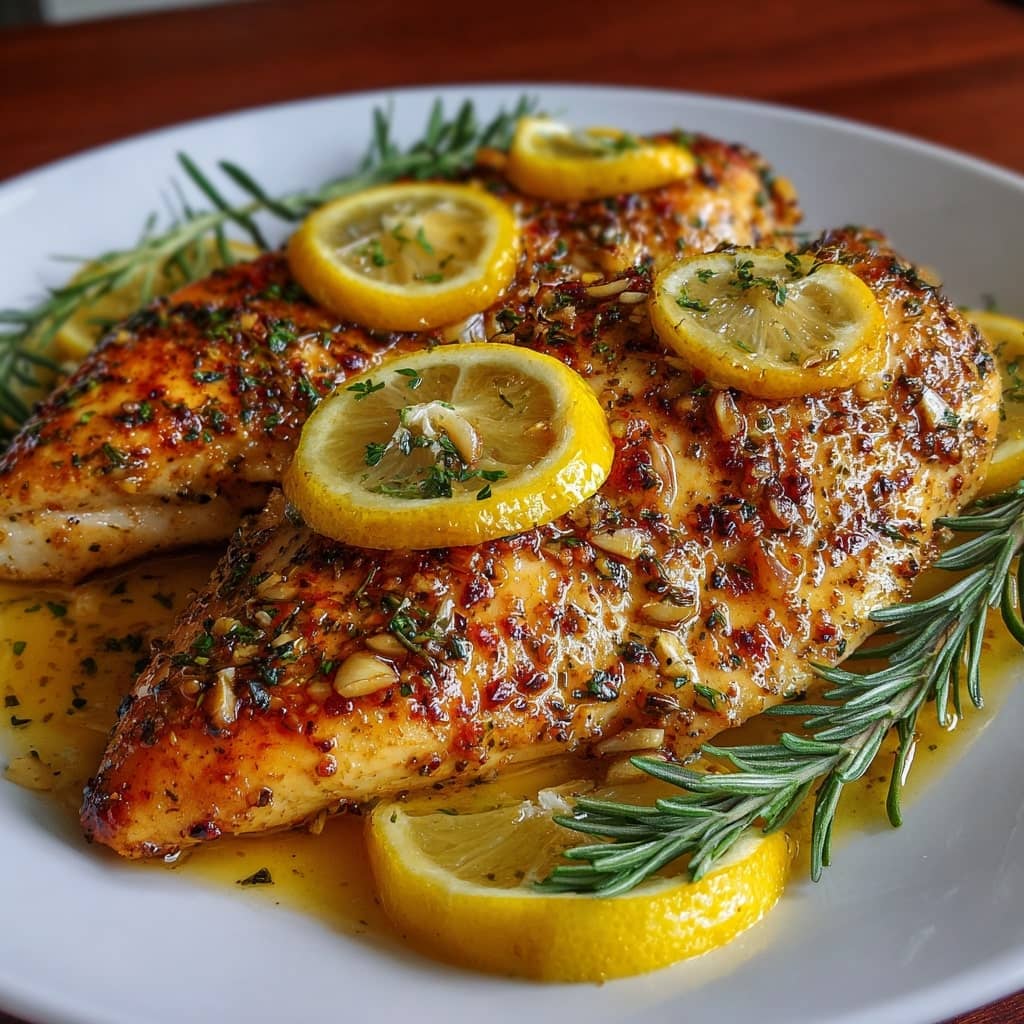Few dishes strike the perfect balance between simplicity and bold flavor quite like Easy Lemon Garlic Chicken. This dish combines zesty lemon, pungent garlic, and tender, juicy chicken in a way that’s both comforting and vibrant. It’s a meal that feels elegant enough for entertaining guests but is easy enough for a quick weeknight dinner. Whether grilled, baked, or pan-seared, lemon garlic chicken is a reliable go-to that works beautifully with sides like roasted vegetables, rice, or fresh salad. Its widespread appeal lies in the way a few humble ingredients come together to create a flavorful and wholesome meal with minimal effort and maximum reward.
The History of Lemon Garlic Chicken
Lemon garlic chicken is not tied to one specific culture but rather emerges from a shared culinary language that spans the Mediterranean, Middle East, and even parts of Asia. Lemon and garlic have been staples in Mediterranean cooking for centuries. Ancient Greeks and Romans used lemon for both flavor and preservation, while garlic was prized for its health benefits and sharp flavor. In Middle Eastern cuisines, lemon juice and garlic are often used in marinades for grilled meats and kebabs. The combination spread and evolved across continents with European colonization and global trade. In France, you’ll find similar dishes like “Poulet au Citron et Ail.” In Italy, lemon garlic sauces are common in both chicken and seafood preparations. Meanwhile, in North Africa and the Levant, the pairing is key in tagines and shawarma-style dishes. In modern Western kitchens, the dish gained popularity as a healthy, quick-prep dinner in the 1990s and 2000s, especially as lemon and garlic became associated with clean, flavorful eating. Today, it’s a universally loved recipe that’s endlessly adaptable and shows up in everything from 30-minute meals to elaborate dinner party menus.
Ingredients Breakdown
The core ingredients of Easy Lemon Garlic Chicken are few but mighty. You’ll need boneless, skinless chicken breasts or thighs—thighs offer more juiciness, while breasts are leaner and cook quicker. Fresh garlic is essential; its pungency mellows beautifully when sautéed or baked. Lemon juice adds brightness, acidity, and a subtle tang that cuts through the richness of the meat. Lemon zest adds even more citrus aroma. Olive oil serves as the base for marinades and sautéing, helping carry the flavors and keeping the chicken moist. Salt and black pepper are foundational seasonings. Optional but highly recommended ingredients include fresh herbs like parsley, thyme, oregano, or rosemary, which layer in earthy or floral notes. A touch of honey or Dijon mustard can be added for complexity and balance. For spice lovers, red pepper flakes or paprika bring subtle heat. If marinating, yogurt or buttermilk can be used to tenderize the meat further. Altogether, the ingredients create a flavor profile that is fresh, savory, and deeply satisfying.
Step-by-Step Recipe
- Prepare the Chicken: Start by patting 1½ to 2 pounds of boneless, skinless chicken breasts or thighs dry with paper towels. If the breasts are thick, consider slicing them horizontally for more even cooking. 2. Make the Marinade: In a mixing bowl, combine 3 tablespoons of olive oil, the juice and zest of 1 lemon, 4 cloves of garlic (minced), 1 teaspoon salt, ½ teaspoon black pepper, and optional herbs like 1 teaspoon dried oregano or 1 tablespoon chopped fresh parsley. 3. Marinate the Chicken: Place the chicken in a resealable plastic bag or shallow dish and pour the marinade over it. Let it sit for at least 30 minutes at room temperature or up to 4 hours in the refrigerator. 4. Cook the Chicken: Heat a large skillet over medium-high heat. Add a drizzle of olive oil. Remove the chicken from the marinade (letting excess drip off) and place it in the hot pan. Sear for 4–5 minutes per side until golden and fully cooked (internal temperature should reach 165°F/74°C). If baking, preheat oven to 400°F (200°C) and bake for 20–25 minutes, turning once halfway through. 5. Deglaze the Pan (Optional): For extra flavor, after removing the chicken, add a splash of chicken broth or water and a squeeze of lemon juice to the skillet. Scrape up the browned bits and pour the sauce over the chicken. 6. Garnish and Serve: Garnish the finished chicken with chopped parsley, extra lemon zest, and a few lemon slices. Serve hot with rice, couscous, quinoa, or roasted vegetables.
Tips for the Perfect Lemon Garlic Chicken
Use fresh lemon juice and zest for the best flavor—bottled lemon juice lacks the brightness of fresh citrus. Always let the chicken marinate for at least 30 minutes to allow the flavors to penetrate the meat. Don’t overcrowd the pan when cooking; cook in batches if needed to ensure even browning. Use a meat thermometer to avoid overcooking—chicken is done at 165°F. If using garlic in the pan sauce, be careful not to burn it; burnt garlic tastes bitter. For more depth, add a splash of white wine or chicken broth to the pan after searing. Finish with a drizzle of olive oil or a knob of butter just before serving to enhance richness. Let the cooked chicken rest for a few minutes before slicing to retain juices. If baking, consider covering the dish with foil for the first half of baking to retain moisture, then uncover to finish with browning. Always taste and adjust seasoning at the end—lemon intensity varies, and a final pinch of salt or squeeze of juice can brighten the dish beautifully.
Variations and Customizations
Lemon garlic chicken is incredibly versatile. For a Greek-inspired version, add a few tablespoons of plain Greek yogurt to the marinade along with oregano and serve with tzatziki and pita. For a Mediterranean flair, include olives, sun-dried tomatoes, and capers. Make it creamy by stirring a splash of cream or coconut milk into the pan sauce. Swap chicken for turkey cutlets, shrimp, or tofu for dietary needs. Add vegetables like zucchini, bell peppers, or cherry tomatoes to the same pan during baking for a one-pan meal. Grill the chicken for a smoky, charred version perfect for summer. Bread the chicken lightly before searing if you prefer a crispy crust. Use preserved lemon for a Moroccan twist or tamari and sesame oil for a fusion spin. Top with feta, shaved Parmesan, or toasted pine nuts for added texture. Serve over a salad for a light meal or alongside mashed potatoes for comfort food at its finest.
Health Considerations and Nutritional Value
Lemon garlic chicken is naturally high in protein and low in carbohydrates, making it an excellent option for many diets including paleo, keto, Whole30, and Mediterranean-style eating. A typical serving made with skinless chicken breast contains around 220–280 calories, 25–30g of protein, 12g of fat, and negligible carbs. Using chicken thighs increases fat content but adds more iron and flavor. Lemon juice is rich in vitamin C and enhances iron absorption. Garlic is known for its anti-inflammatory and cardiovascular benefits. Olive oil offers heart-healthy monounsaturated fats. To keep it light, avoid adding cream-based sauces or heavy sides. For sodium control, reduce salt or use low-sodium broth. Add fiber by pairing with quinoa or a fresh green salad. The dish is naturally gluten-free and dairy-free unless additions like cream or cheese are included. With balanced ingredients and thoughtful preparation, lemon garlic chicken offers both indulgence and nutritional value in one dish.
FAQ
Q: Can I use bottled lemon juice instead of fresh?
A: You can, but fresh lemon juice and zest provide significantly better flavor and aroma.
Q: What cut of chicken works best?
A: Both chicken thighs and breasts work well. Thighs are juicier, while breasts are leaner and cook faster.
Q: How long should I marinate the chicken?
A: Marinate for at least 30 minutes and up to 4 hours. Avoid overnight marinating, especially with acidic lemon juice, which can toughen the meat.
Q: Can I cook it in the oven instead of a skillet?
A: Absolutely. Bake at 400°F (200°C) for 20–25 minutes or until internal temperature reaches 165°F.
Q: Can I freeze lemon garlic chicken?
A: Yes. You can freeze the uncooked marinated chicken or cooked leftovers. Thaw in the fridge overnight before reheating.
Q: What sides pair well with lemon garlic chicken?
A: Great options include rice, couscous, roasted vegetables, mashed potatoes, or a crisp green salad.
Q: Can I make this dish dairy-free or gluten-free?
A: Yes, it is naturally both unless you add cheese or use sauces that contain gluten. Always check labels if needed.
Q: Can I meal prep this?
A: Yes. Cooked lemon garlic chicken stores well in the fridge for up to 4 days and reheats beautifully.

Easy Lemon Garlic Chicken
Ingredients
- 4 boneless skinless chicken breasts (about 2 pounds total), pounded to ½-inch thickness
- ½ teaspoon kosher salt plus additional for seasoning
- ¼ teaspoon freshly ground black pepper plus additional for seasoning
- 1 tablespoon olive oil
- 3 tablespoons unsalted butter
- 1 small shallot finely chopped
- 4 cloves garlic minced
- 2 tablespoons all-purpose flour
- 1 cup half-and-half or whole milk
- ½ cup low-sodium chicken broth
- Juice of 1 medium lemon approximately 3 tablespoons
- 2 tablespoons fresh parsley finely chopped
- 1 small lemon thinly sliced
Instructions
- Pat the chicken dry thoroughly using paper towels, then season generously on all sides with salt and pepper. In a 10-inch or larger skillet, heat the olive oil over medium-high heat until it shimmers. Working in batches if necessary, add the chicken and sear undisturbed until the bottom is deeply browned, about 6 to 7 minutes. Flip using tongs and sear the other side for another 6 to 7 minutes, until evenly browned. Transfer the chicken to a plate and set aside. Reduce the heat to medium and add the butter to the skillet. Once melted, add the chopped shallot, minced garlic, ½ teaspoon of salt, and ¼ teaspoon of pepper. Cook, stirring occasionally, until the shallots just begin to soften, about 1 minute. Sprinkle in the flour and stir to coat the shallots and garlic evenly, cooking for 1 more minute. Slowly pour in the half-and-half or milk and chicken broth, stirring constantly to eliminate any lumps and scraping up the browned bits from the bottom of the pan. Bring the mixture to a boil, then reduce the heat to maintain a simmer. Return the chicken and any accumulated juices to the skillet. Simmer for 3 to 4 minutes, or until the sauce has thickened enough to coat the back of a spoon and the chicken is fully cooked through. Stir in the lemon juice, then garnish with chopped parsley and lemon slices. Serve immediately.

